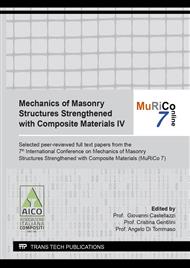p.66
p.74
p.82
p.91
p.98
p.105
p.115
p.123
p.130
Bamboo Fibers for the Reinforcement of Mortar and Plaster
Abstract:
Over the decades, innovative techniques have been introduced and developed in the building heritage which make use of composite materials whose main objectives are bending and shear reinforcement, increasing ductility and limiting cracks. The use of composite materials with steel, carbon, glass and aramid fibers are already codified in the technical standards, now the challenge is the use of more sustainable materials. This paper focuses on a simple and effective bamboo fibers reinforcement of structural and non-structural commercial products such as mortar and plaster with different mechanical characteristics, trying to improve ductility without worsening their strength and mechanical stiffness. In particular, a plaster and a mortar with 2% (by weight) of bamboo fibers of Phyllostachys Iridescens species has been analyzed. A mechanical characterization is carried out evaluating flexural strength, compressive strength and fracture energy. The effectiveness of the reinforcement is shown through the comparison with the unreinforced materials.
Info:
Periodical:
Pages:
98-104
Citation:
Online since:
April 2022
Authors:
Keywords:
Price:
Сopyright:
© 2022 Trans Tech Publications Ltd. All Rights Reserved
Share:
Citation:


